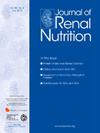The Effect of Dietary Fiber on Hyperkalemia in Maintenance Hemodialysis Patients: A Cross-Sectional Study
IF 3.2
3区 医学
Q2 NUTRITION & DIETETICS
引用次数: 0
Abstract
Objective
To explore the relationship between dietary fiber (DF) intake and hyperkalemia in maintenance hemodialysis (MHD) patients.
Methods
A total of 110 MHD patients were included, including 67 males and 43 females. Patients were divided into normal serum potassium group (N) and a hyperkalemia group (H) according to the serum potassium level before dialysis. The daily diet was recorded by the 3-day dietary recording method. The daily dietary nutrient intake of patients was analyzed. Logistic regression was used to analyze the relationship between hyperkalemia and DF intake. A receiver operating characteristic curve was used to analyze the cutoff value of DF intake to prevent hyperkalemia.
Results
Of the 110 patients, 38 had hyperkalemia (serum potassium >5.5 mmol/L) before dialysis. There was no difference in sex, residual kidney function, body mass index, energy intake, fat intake, protein intake, calcium intake, sodium intake, phosphorus intake or the administration history of potassium-lowering drugs between the 2 groups (P > .05). Compared with the H group, patients in the N group had higher carbohydrate intake (315 ± 76 g/d vs. 279 ± 66 g/d, P = .016), dietary fiber intake (19 ± 5 g/d vs. 12 ± 8 g/d, P < .0001), and potassium intake (1,698 ± 392 mg/d vs. 1,533 ± 413 mg/d, P = .041), and more patients in group N used renin-angiotensin-aldosterone system inhibitors (52.78% vs. 23.68%, P = .003). However, the number of patients with constipation in group N was less than that in group H (20.83% vs. 42.11%, P = .018). Logistic regression analysis showed that DF intake was an independent protective factor for hyperkalemia [P < .0001, odds ratio = 0.766 (95% confidence intervals: 0.675-0.870)]. Receiver operating characteristic analysis showed that daily intake of DF greater than 15.33 g may be helpful to prevent hyperkalemia.
Conclusion
Insufficient dietary nutrient intake is prevalent in MHD patients, especially DF intake, which may be associated with hyperkalemia. Clinically, attention should be given to the dietary balance of MHD patients, especially DF intake.
膳食纤维对维持性血液透析患者高钾血症的影响:一项横断面研究。
目的探讨维持性血液透析(MHD)患者膳食纤维(DF)摄入量与高钾血症之间的关系:方法:共纳入 110 名维持性血液透析(MHD)患者,包括 67 名男性和 43 名女性。根据透析前的血清钾水平将患者分为血清钾正常组(N)和高血钾组(H)。每日饮食采用 3 天饮食记录法进行记录。对患者每日饮食营养摄入量进行分析。采用 Logistic 回归分析高钾血症与 DF 摄入量之间的关系。采用接收者操作特征曲线(ROC)分析预防高钾血症的 DF 摄入量临界值:结果:在 110 名患者中,38 人在透析前患有高钾血症(血清钾 > 5.5 mmol/L)。两组患者在性别、残余肾功能、体重指数(BMI)、能量摄入量、脂肪摄入量、蛋白质摄入量、钙摄入量、钠摄入量、磷摄入量和降钾药使用史方面均无差异(P > 0.05)。与 H 组相比,N 组患者的碳水化合物摄入量(315±76 克/天 vs. 279±66 克/天,P=0.016)和膳食纤维摄入量(19±5 克/天 vs. 12±8 克/天,P=0.016)更高:MHD患者普遍存在膳食营养摄入不足的问题,尤其是DF摄入不足,这可能与高钾血症有关。临床上应注意 MHD 患者的膳食平衡,尤其是 DF 摄入量。
本文章由计算机程序翻译,如有差异,请以英文原文为准。
求助全文
约1分钟内获得全文
求助全文
来源期刊

Journal of Renal Nutrition
医学-泌尿学与肾脏学
CiteScore
5.70
自引率
12.50%
发文量
146
审稿时长
6.7 weeks
期刊介绍:
The Journal of Renal Nutrition is devoted exclusively to renal nutrition science and renal dietetics. Its content is appropriate for nutritionists, physicians and researchers working in nephrology. Each issue contains a state-of-the-art review, original research, articles on the clinical management and education of patients, a current literature review, and nutritional analysis of food products that have clinical relevance.
 求助内容:
求助内容: 应助结果提醒方式:
应助结果提醒方式:


